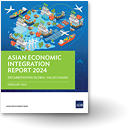Goodbye, People’s Republic of China. Hello (again), America?
For two decades, the People’s Republic of China’s (PRC) processing trade has made it the “world’s factory”. The PRC has conquered the art of assembling goods using imported inputs and abundant Chinese labor, and then exporting them—phenomenally lowering costs and prices worldwide.
But is the era of cheap China nearing its end? If the behavior of multinational companies (MNCs) is any indication, there appears to be growing evidence. The phenomenon of MNCs moving manufacturing operations back to the US hints at a fading fascination with the PRC as the default choice.</>
It is estimated that some 25,000 manufacturing jobs have already trickled back to the US— not so much to cause an uproar—but enough to catch attention. Whirlpool has restored the assembly of its KitchenAid hand mixers from Huizhou to Ohio, and is considering returning production of its other small appliances. Caterpillar is likewise shifting parts of its excavator production to Texas. U.S. President Obama has hailed Master Lock, maker of padlocks and security products, for bringing back jobs to the US as well.
Rising wages in the PRC coupled with higher shipping costs (due to rising oil prices) are closing the cost gap between the PRC and the US. The PRC’s average minimum wage shot up by 22% over the past two years on the back of mandatory wage increases and labor shortage, whereas wage growth in the US had been sluggish. According to one report, in 2005 the cost of electric motors for vehicle windshield wipers made in the PRC was 45% less than a US-made model; today it is 18% less. By 2015, it will only be 9% cheaper.
The “reshoring” trend is also underscored in several surveys of manufacturing companies. A Boston Consulting Group (BCG) survey found more than a third of large US-based producers are either planning or seriously considering returning overseas production to the US. In another survey, 46% of executives at European and North American manufacturing firms are looking at shifting some production from the PRC to the US, while 27% are either planning or are already in the process of reshoring. Separately, 40 out of 105 companies surveyed by a US-based supply-chain expert are considering bringing jobs back to the US.
BCG has identified seven “tipping point sectors”, where labor arbitrage gains from manufacturing in the PRC are shrinking: (1) transportation goods; (2) appliances and electrical equipment; (3) furniture; (4) plastic and rubber products; (5) machinery; (6) fabricated metal products; and (7) computers and electronics. For these industries, the savings from shipping and inventory, and the higher productivity of American workers make up for the higher labor costs in the US. According to BCG, an American worker armed with US technology is more than three times as productive as a Chinese worker. Due to greater automation, labor costs represent a small fraction of the total cost in these industries.
General Electric and Whirlpool, for instance, decided to pull some of their manufacturing from the PRC and head back to the US, partly due to rising shipping costs. The higher cost of labor in the US was not a stumbling block for Seesmart, Inc. since labor contributes to less than 2% of the total production cost of lighting. Moreover, the company has managed to save around 30% on logistics.
For low-cost, labor-intensive industries, however, a US comeback may never happen. With wages escalating in the PRC, manufacturing in these industries may move toward countries with relatively cheap labor such as some ASEAN member states or even Mexico. Myanmar could become the choice destination for low-cost industries such as textiles. But it is not only the MNCs that have been making the move. Even Chinese companies have started building industrial complexes in countries such as Viet Nam.
Clearly, a redistribution of global manufacturing as a result of the end of cheap China is at work. This will vary across industries depending on labor content, shipping costs, the PRC’s competitive advantage, and the specific needs of the company.
So it seems the “end of cheap China” is just around the corner. But it is not the end of manufacturing in the PRC. The PRC will still remain as a manufacturing powerhouse for consumer electronics and other higher value-added goods, given its sophisticated supply networks, large pool of skilled labor, and reliable infrastructure—unmatched by other low-cost developing countries.
For some, there is really no easy alternative to the PRC.




